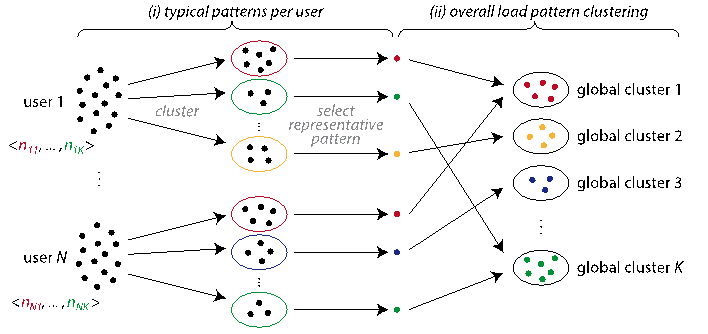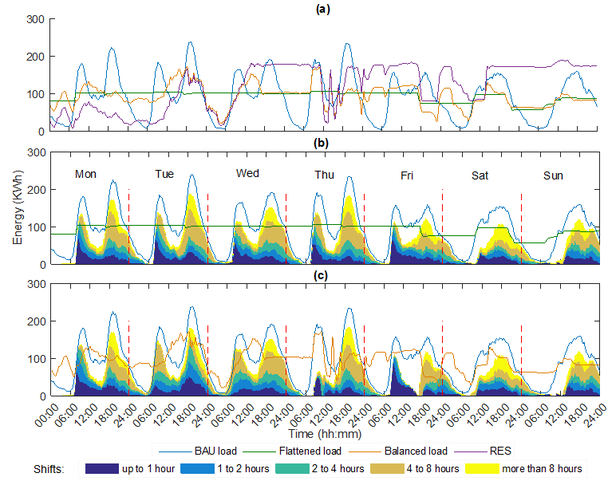Smart Grids
Power grids are transitioning to smart grids, partly to reduce CO2 footprint.
This includes deployment of renewable energy sources (RES), e.g., solar and wind energy. RES incur major challenges in ensuring that load is always balanced by production. Demand response (DR) algorithms are a key (part of the) solution to this balancing problem, aiming to steer power consumption. To successfully deploy DR, it is of prime importance to thoroughly characterize (and possibly predict) consumption patterns, and especially what part can be shifted in time (e.g., to match RES production).
This characterization requires advanced data analytics, and machine learning algorithms are highly valuable both to automatically detect/learn power consumption behavior as well as control it (e.g., in RES balancing).
Some of the topics we recently have been working on in this area include the following:
- Scalable load profile clustering: in contrast to state-of-the-art that a priori imposes different classes (e.g., week- vs weekend days), we study unsupervised algorithms that do not make any a priori assumptions about such classes, and adopt feature representations to improve scalability of the algorithms.
- Quantitative flexibility assessment based on real-world data: we characterize behavior of users with statistical models, and derive the flexibility (i.e., over what time frames we can shift power consumption, and what load volume that amounts to) that is exhibited in such observed electrical load patterns.
- Non-intrusive load monitoring (NILM): we are working on improved NILM algorithms, i.e., decomposing total consumption measurement into individual device consumption. We investigate new features (e.g., inactive current, binarized VI trajectories), and explore the potential of recent advances in machine learning for device classification (e.g., using deep learning).
Complementary to this data analytics and machine learning line of work, we also contribute to communication software approaches, e.g., based on information centric networking (ICN) approaches such as in the C-DAX project.
Staff
Chris Develder, Tom Dhaene, Matthias Strobbe, Dirk Deschrijver
Researchers
Nasrin Sadeghianpourhamami, Leen De Baets, Joeri Ruyssinck.
Projects
- FP7 C-DAX
- FP7 Increase
- ICON Monieflex
- ICON Swift
Key publications
- N. Sadeghianpourhamami, T. Demeester, D.F. Benoit, M. Strobbe and C. Develder, "Modeling and analysis of residential flexibility: Timing of white good usage", Appl. Energy, Vol. 179, Oct. 2016, pp. 790-805.
- K. Mets, F. Depuydt and C. Develder, "Two-stage load pattern clustering using fast wavelet transformation", IEEE Trans. Smart Grid, Vol. 7, No. 5, Jul. 2015, pp. 2250-2259.
- W.K. Chai, N. Wang, K. Katsaros, G. Kamel, S. Melis, M. Hoefling, B. Vieira, P. Romano, S. Sarri, T. Tesfay, B. Yang, F. Heimgaertner, M. Pignati, M. Paolone, M. Menth, G. Pavlou, E. Poll, M. Mampaey, H. Bontius and C. Develder, "An information-centric communication infrastructure for real-time state estimation of active distribution networks", IEEE Trans. Smart Grid, Vol. 6, No. 4, Jul. 2015, pp. 2134-2146.
- J. van der Herten, F. Depuydt, D. Deschrijver, M. Strobbe, C. Develder, T. Dhaene, R. Bruneliere and J.-W. Rombouts, "Energy flexibility assessment of an industrial coldstore process", in Proc. IEEE Int. Energy Conf. (Energycon 2016), Leuven, Belgium, 4-8 Apr. 2016, pp. 1-6.
- L. De Baets, J. Ruyssinck, D. Deschrijver, T. Dhaene, “Event detection in NILM using Cepstrum smoothing”, in Proc. 3rd Int. Workshop on Non-Intrusive Load Monitoring (NILM 2016), Vancouver, Canada, 14-15 May 2016, pp. 1-4.

